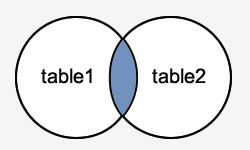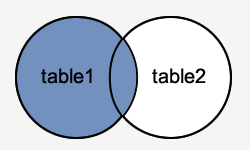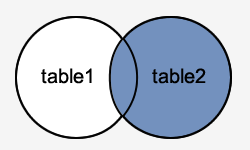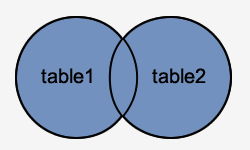This SQL Server tutorial explains how to use JOINS, both INNER and OUTER JOINS, in SQL Server (Transact-SQL) with syntax, visual illustrations, and examples.
Description
SQL Server (Transact-SQL) JOINS are used to retrieve data from multiple tables. A SQL Server JOIN is performed whenever two or more tables are joined in a SQL statement.
There are 4 different types of SQL Server joins:
- SQL Server INNER JOIN (or sometimes called simple join)
- SQL Server LEFT OUTER JOIN (or sometimes called LEFT JOIN)
- SQL Server RIGHT OUTER JOIN (or sometimes called RIGHT JOIN)
- SQL Server FULL OUTER JOIN (or sometimes called FULL JOIN)
So let's discuss SQL Server JOIN syntax, look at visual illustrations of SQL Server JOINS, and explore SQL Server JOIN examples.
INNER JOIN (simple join)
Chances are, you've already written a statement that uses an SQL Server INNER JOIN. It is the most common type of join. SQL Server INNER JOINS return all rows from multiple tables where the join condition is met.
Syntax
The syntax for the INNER JOIN in SQL Server (Transact-SQL) is:
SELECT columns
FROM table1
INNER JOIN table2
ON table1.column = table2.column;
Visual Illustration
In this visual diagram, the SQL Server INNER JOIN returns the shaded area:

The SQL Server INNER JOIN would return the records where table1 and table2 intersect.
Example
Here is an example of an INNER JOIN in SQL Server (Transact-SQL):
SELECT suppliers.supplier_id, suppliers.supplier_name, orders.order_date
FROM suppliers
INNER JOIN orders
ON suppliers.supplier_id = orders.supplier_id;
This SQL Server INNER JOIN example would return all rows from the suppliers and orders tables where there is a matching supplier_id value in both the suppliers and orders tables.
Let's look at some data to explain how the INNER JOINS work:
We have a table called suppliers with two fields (supplier_id and supplier_name). It contains the following data:
| supplier_id |
supplier_name |
| 10000 |
IBM |
| 10001 |
Hewlett Packard |
| 10002 |
Microsoft |
| 10003 |
NVIDIA |
We have another table called orders with three fields (order_id, supplier_id, and order_date). It contains the following data:
| order_id |
supplier_id |
order_date |
| 500125 |
10000 |
2003/05/12 |
| 500126 |
10001 |
2003/05/13 |
| 500127 |
10004 |
2003/05/14 |
If we run the SQL Server SELECT statement (that contains an INNER JOIN) below:
SELECT suppliers.supplier_id, suppliers.supplier_name, orders.order_date
FROM suppliers
INNER JOIN orders
ON suppliers.supplier_id = orders.supplier_id;
Our result set would look like this:
| supplier_id |
name |
order_date |
| 10000 |
IBM |
2003/05/12 |
| 10001 |
Hewlett Packard |
2003/05/13 |
The rows for Microsoft and NVIDIA from the supplier table would be omitted, since the supplier_id's 10002 and 10003 do not exist in both tables. The row for 500127 (order_id) from the orders table would be omitted, since the supplier_id 10004 does not exist in the suppliers table.
Old Syntax
As a final note, it is worth mentioning that the SQL Server INNER JOIN example above could be rewritten using the older implicit syntax as follows (but we still recommend using the INNER JOIN keyword syntax):
SELECT suppliers.supplier_id, suppliers.supplier_name, orders.order_date
FROM suppliers, orders
WHERE suppliers.supplier_id = orders.supplier_id;
LEFT OUTER JOIN
Another type of join is called a SQL Server LEFT OUTER JOIN. This type of join returns all rows from the LEFT-hand table specified in the ON condition and only those rows from the other table where the joined fields are equal (join condition is met).
Syntax
The syntax for the LEFT OUTER JOIN in SQL Server (Transact-SQL) is:
SELECT columns
FROM table1
LEFT [OUTER] JOIN table2
ON table1.column = table2.column;
In some databases, the LEFT OUTER JOIN keywords are replaced with LEFT JOIN.
Visual Illustration
In this visual diagram, the SQL Server LEFT OUTER JOIN returns the shaded area:

The SQL Server LEFT OUTER JOIN would return the all records from table1 and only those records from table2 that intersect with table1.
Example
Here is an example of a LEFT OUTER JOIN in SQL Server (Transact-SQL):
SELECT suppliers.supplier_id, suppliers.supplier_name, orders.order_date
FROM suppliers
LEFT OUTER JOIN orders
ON suppliers.supplier_id = orders.supplier_id;
This LEFT OUTER JOIN example would return all rows from the suppliers table and only those rows from the orders table where the joined fields are equal.
If a supplier_id value in the suppliers table does not exist in the orders table, all fields in the orders table will display as <null> in the result set.
Let's look at some data to explain how LEFT OUTER JOINS work:
We have a table called suppliers with two fields (supplier_id and supplier_name). It contains the following data:
| supplier_id |
supplier_name |
| 10000 |
IBM |
| 10001 |
Hewlett Packard |
| 10002 |
Microsoft |
| 10003 |
NVIDIA |
We have a second table called orders with three fields (order_id, supplier_id, and order_date). It contains the following data:
| order_id |
supplier_id |
order_date |
| 500125 |
10000 |
2003/05/12 |
| 500126 |
10001 |
2003/05/13 |
If we run the SELECT statement (that contains a LEFT OUTER JOIN) below:
SELECT suppliers.supplier_id, suppliers.supplier_name, orders.order_date
FROM suppliers
LEFT OUTER JOIN orders
ON suppliers.supplier_id = orders.supplier_id;
Our result set would look like this:
| supplier_id |
supplier_name |
order_date |
| 10000 |
IBM |
2003/05/12 |
| 10001 |
Hewlett Packard |
2003/05/13 |
| 10002 |
Microsoft |
<null> |
| 10003 |
NVIDIA |
<null> |
The rows for Microsoft and NVIDIA would be included because a LEFT OUTER JOIN was used. However, you will notice that the order_date field for those records contains a <null> value.
RIGHT OUTER JOIN
Another type of join is called a SQL Server RIGHT OUTER JOIN. This type of join returns all rows from the RIGHT-hand table specified in the ON condition and only those rows from the other table where the joined fields are equal (join condition is met).
Syntax
The syntax for the RIGHT OUTER JOIN in SQL Server (Transact-SQL) is:
SELECT columns
FROM table1
RIGHT [OUTER] JOIN table2
ON table1.column = table2.column;
In some databases, the RIGHT OUTER JOIN keywords are replaced with RIGHT JOIN.
Visual Illustration
In this visual diagram, the SQL Server RIGHT OUTER JOIN returns the shaded area:

The SQL Server RIGHT OUTER JOIN would return the all records from table2 and only those records from table1 that intersect with table2.
Example
Here is an example of a RIGHT OUTER JOIN in SQL Server (Transact-SQL):
SELECT orders.order_id, orders.order_date, suppliers.supplier_name
FROM suppliers
RIGHT OUTER JOIN orders
ON suppliers.supplier_id = orders.supplier_id;
This RIGHT OUTER JOIN example would return all rows from the orders table and only those rows from the suppliers table where the joined fields are equal.
If a supplier_id value in the orders table does not exist in the suppliers table, all fields in the suppliers table will display as <null> in the result set.
Let's look at some data to explain how RIGHT OUTER JOINS work:
We have a table called suppliers with two fields (supplier_id and supplier_name). It contains the following data:
| supplier_id |
supplier_name |
| 10000 |
Apple |
| 10001 |
Google |
We have a second table called orders with three fields (order_id, supplier_id, and order_date). It contains the following data:
| order_id |
supplier_id |
order_date |
| 500125 |
10000 |
2013/08/12 |
| 500126 |
10001 |
2013/08/13 |
| 500127 |
10002 |
2013/08/14 |
If we run the SELECT statement (that contains a RIGHT OUTER JOIN) below:
SELECT orders.order_id, orders.order_date, suppliers.supplier_name
FROM suppliers
RIGHT OUTER JOIN orders
ON suppliers.supplier_id = orders.supplier_id;
Our result set would look like this:
| order_id |
order_date |
supplier_name |
| 500125 |
2013/08/12 |
Apple |
| 500126 |
2013/08/13 |
Google |
| 500127 |
2013/08/14 |
<null> |
The row for 500127 (order_id) would be included because a RIGHT OUTER JOIN was used. However, you will notice that the supplier_name field for that record contains a <null> value.
FULL OUTER JOIN
Another type of join is called a SQL Server FULL OUTER JOIN. This type of join returns all rows from the LEFT-hand table and RIGHT-hand table with nulls in place where the join condition is not met.
Syntax
The syntax for the FULL OUTER JOIN in SQL Server (Transact-SQL) is:
SELECT columns
FROM table1
FULL [OUTER] JOIN table2
ON table1.column = table2.column;
In some databases, the FULL OUTER JOIN keywords are replaced with FULL JOIN.
Visual Illustration
In this visual diagram, the SQL Server FULL OUTER JOIN returns the shaded area:

The SQL Server FULL OUTER JOIN would return the all records from both table1 and table2.
Example
Here is an example of a FULL OUTER JOIN in SQL Server (Transact-SQL):
SELECT suppliers.supplier_id, suppliers.supplier_name, orders.order_date
FROM suppliers
FULL OUTER JOIN orders
ON suppliers.supplier_id = orders.supplier_id;
This FULL OUTER JOIN example would return all rows from the suppliers table and all rows from the orders table and whenever the join condition is not met, <nulls> would be extended to those fields in the result set.
If a supplier_id value in the suppliers table does not exist in the orders table, all fields in the orders table will display as <null> in the result set. If a supplier_id value in the orders table does not exist in the suppliers table, all fields in the suppliers table will display as <null> in the result set.
Let's look at some data to explain how FULL OUTER JOINS work:
We have a table called suppliers with two fields (supplier_id and supplier_name). It contains the following data:
| supplier_id |
supplier_name |
| 10000 |
IBM |
| 10001 |
Hewlett Packard |
| 10002 |
Microsoft |
| 10003 |
NVIDIA |
We have a second table called orders with three fields (order_id, supplier_id, and order_date). It contains the following data:
| order_id |
supplier_id |
order_date |
| 500125 |
10000 |
2013/08/12 |
| 500126 |
10001 |
2013/08/13 |
| 500127 |
10004 |
2013/08/14 |
If we run the SELECT statement (that contains a FULL OUTER JOIN) below:
SELECT suppliers.supplier_id, suppliers.supplier_name, orders.order_date
FROM suppliers
FULL OUTER JOIN orders
ON suppliers.supplier_id = orders.supplier_id;
Our result set would look like this:
| supplier_id |
supplier_name |
order_date |
| 10000 |
IBM |
2013/08/12 |
| 10001 |
Hewlett Packard |
2013/08/13 |
| 10002 |
Microsoft |
<null> |
| 10003 |
NVIDIA |
<null> |
| <null> |
<null> |
2013/08/14 |
The rows for Microsoft and NVIDIA would be included because a FULL OUTER JOIN was used. However, you will notice that the order_date field for those records contains a <null> value.
The row for supplier_id 10004 would be also included because a FULL OUTER JOIN was used. However, you will notice that the supplier_id and supplier_name field for those records contain a <null> value.
